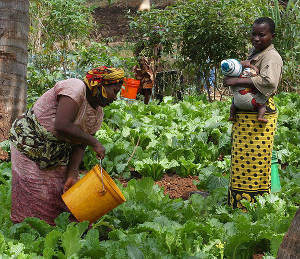Many of the articles on our blog focus on mHealth and mWomen interventions. Yet, such a large segment of the population in developing countries are smallholder or subsistence farmers (for example 65 percent in sub-Saharan Africa). This, along with the statistic that women contribute 60 to 80 percent of the labor used in subsistence farming (some dispute this claim), compelled me to research how mobile technology (M4D) is being used for agriculture.
Food production systems continue to rapidly change in the developing world, leaving behind many smallholder farmers who need to adjust to both changes in production and the difficulty of accessing market information. The use of technology in agriculture seems to be just the solution. mAgriculture programs, as appropriately labeled within the mobile for development (M4D) sector, are being implemented or designed all over the developing world – in Asia, Latin America, and Africa – to try to address these and other issues. These mobile technology projects range from allowing farmers in India to ask experts questions about planting, pesticides, and other farming best practices to informing farmers in Uganda of the market prices for different crops.
During my research, I came across an interesting USAID Briefing Paper, Crowdsourcing Applications for Agricultural Development in Africa, that compelled me to revisit the fundamental questions that mobile for development (M4D) programs should address before implementing a solution. USAID’s Briefing Paper addresses the intersection between crowdsourcing and mobile agriculture initiatives, i.e., how crowdsourcing information from smallholder farmers and other stakeholders can “improve the impact of agriculture projects.”
The paper also raises several questions to consider when trying to decide whether crowdsourcing would be a good fit for your new mobile agriculture initiative. Two of the questions stood out to me as so relevant to all M4D programs that I decided to write about them instead and revisit mAgriculture in the future:
- Do target users have access to and literacy in using mobile phones?
- What is the incentive for people, aka ‘the crowd,’ to participate?
The first question, in particular, applies to any M4D project. I’ve interviewed many organizations that implement M4D projects, and one key insight that I’ve come away with is that many times the target users of these interventions often aren’t literate in using mobile phones beyond making phone calls. Some don’t know how to send a new SMS, reply to an SMS they receive, or clear their SMS inboxes so that they can send and receive new text messages. (And that’s only SMS. People who have never used an interactive voice response (IVR) system often have trouble understanding how they work; here’s a program in Pakistan that’s trying to solve that problem using games).
Vital for any M4D project that is interactive, or two-way, in nature – not just programs that involve crowdsourcing – is the second question. Many organizations told me that one of their main fears with implementing polls via mobile phones is that the target user often has no incentive to respond. Even if the phone number they need to text is toll-free (and thus costs the person nothing to respond to the poll), the person still might ignore the message – “why waste my time with this,” they might be thinking. Incentives, therefore, are crucial.
An incentive doesn’t necessarily have to be financial; look at uReport in Uganda. As my colleague Jenny Adlem put it in a previous post, the only incentive people have to respond to uReport polls is “wanting to participate in making their voices heard” – and uReport has more than 200,000 subscribers! The incentive, rather, needs to make users feel that they are getting real value by responding. For farmers in a crowdsourcing/sharing best practices program, it may be enough of an incentive to inform them that sharing their own knowledge will encourage other farmers to also share.
In short, these questions (and others) should be the starting point for anyone designing an M4D program. USAID’s Briefing Paper is a worthwhile read, and I recommend it for anyone interested in this space. And, I promise, we’ll delve into mAgriculture in more detail in future blog posts.

